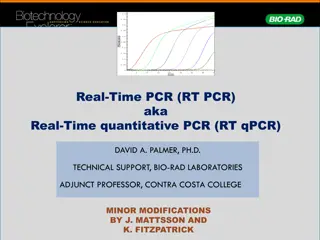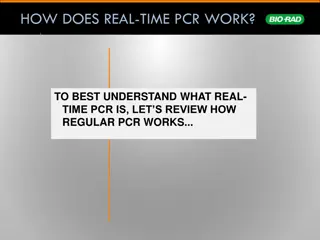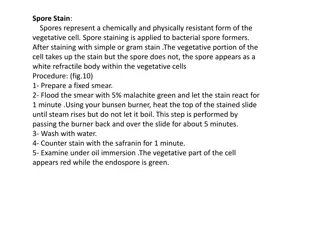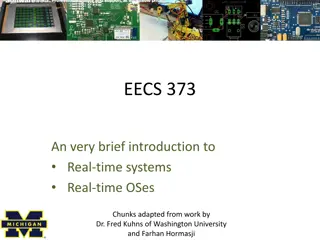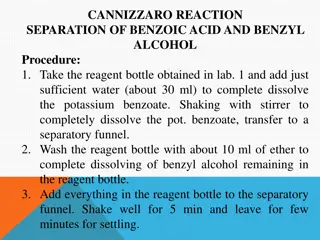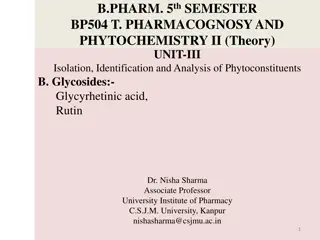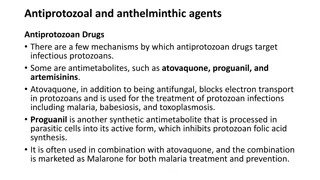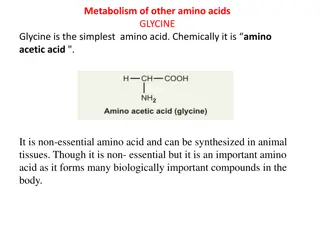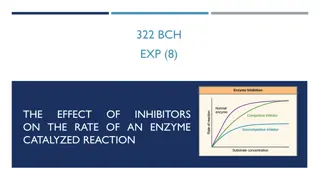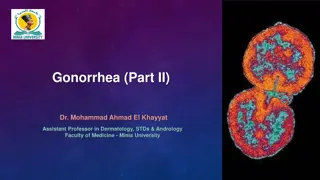Understanding Real-Time PCR: A Modern Technique for Nucleic Acid Analysis
Real-time PCR is a powerful tool for amplifying and quantifying DNA or RNA in a sample. It allows for real-time monitoring of the amplification process, enabling precise quantitation of genetic material and gene expression studies. By combining amplification and detection in one step, real-time PCR reduces the risk of contamination and provides fast, accurate results. Learn about the components, benefits, and applications of this cutting-edge technology.
Download Presentation

Please find below an Image/Link to download the presentation.
The content on the website is provided AS IS for your information and personal use only. It may not be sold, licensed, or shared on other websites without obtaining consent from the author. Download presentation by click this link. If you encounter any issues during the download, it is possible that the publisher has removed the file from their server.
E N D
Presentation Transcript
LABS FOR LIFE PROJECT - INDIA Equipment Management MoHFW /CDC / BD Partnership Project
Thermocycler Introduction Thermocyclers are instruments used to amplify DNA and RNA samples by Polymerase Chain Reaction (PCR). The device has a thermal block with holes where tubes holding the reaction mixtures can be inserted. The cycler then raises and lowers the temperature of the block in discrete, pre-programmed steps. Purpose Detection of the microbe and drug resistance Cloning Sequencing Genotyping
PCR Amplification Cycle 3 major steps in a PCR cycling reaction, which are repeated for 30 or 40 cycles: 1. Denaturation at 94 C 2. Annealing at 55 C 3. Extension at 72 C
Polymerase Chain Reaction Logarithmic amplification of a specific DNA segment by a thermocyclic reaction Components of PCR : Template DNA or RNA Sense and antisense oligonucleotide primers (18-30 nucleotides) dNTP monomers (A,C,G,T) Thermostable DNA polymerase (e.g. Taq) or rTth DNA Polymerase in case RNA is being amplified
Real Time PCR A method that allows to follow amplification of a target in real time Real-time PCR thermocyclers can be used with both DNA and RNA. When amplifying RNA, reverse transcriptase is used to make cDNA and then amplified DNA is analyzed Amplification and detection of pathogens is carried out in the same cycler and same time, hence, the name real time . Combining nucleic acid amplification and detection eliminates the post-amplification process. Real-time PCR is the continuous collection of fluorescent signal from one or more PCR reactions over a range of cycles. The presence of amplification products results in fluorescence which is detected and monitored as the PCR proceeds. Quantitative Real-time PCR is the conversion of the fluorescent signals from each reaction into a numerical value for each sample. This has many advantages including less time taken & minimal chances of contamination since the cycler does not open before the final product.
Real Time PCR machine The Real Time PCR machine has the following main parts Thermal Cycler for amplification A light source for excitation of fluorescent dyes A camera for recording A computer to control the instrument and record/analyze data Uses Precise quantitation of DNA or RNA in samples Estimation of gene number Gene expression studies by quantification of messenger RNA
General Tips for Care and Maintenance Keep the machine in a cool, dry place Always use a UPS- Do not connect the machine directly to the power source Keep the room and the area around the machine dust free Switch off the machine when not in use. Disconnect from power supply at the end of the day Keep the manual of the machine near the machine Maintain a log book-Who? When? Paste the business card of the service engineer on the side of the machine
Maintenance and Calibration Maintenance Ensure that unit is dry and cool and that the power supply is disconnected before performing any cleaning or maintenance. Regular function checks to be performed to check critical characteristics and detect malfunctions before test results are affected. An equipment maintenance and performance evaluation log should be maintained and kept for the duration of clinical use of thermocycler. Thermal cyclers should be routinely monitored for : cycle time reproducibility, verification of temperature accuracy efficiency of heating and cooling rates. These checks are incorporated into the instrument s software and are a part of the manufacturer s recommendations for instrument maintenance. Calibration: Annually Procedure should be followed as per manufacturer s recommendations.
Pre-Training Quiz 1. A thermocycler needs calibration : a. Yearly b. Six monthly c. Quarterly d. Only at the time of installation 2.The following is NOT one of the 3 basic PCR steps: a. Denaturation b. Coiling c. Annealing d. Extension 3. In Real Time PCR, Amplification and Detection happen separately using separate equipment-----True/False


